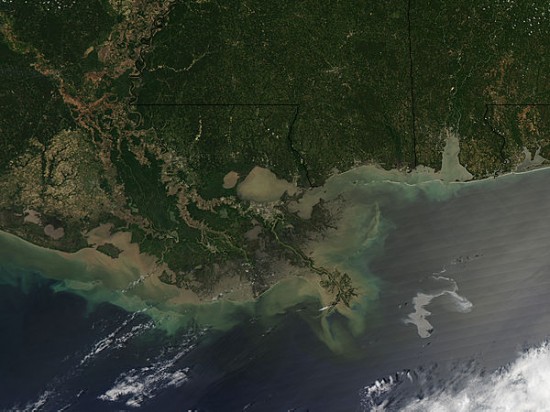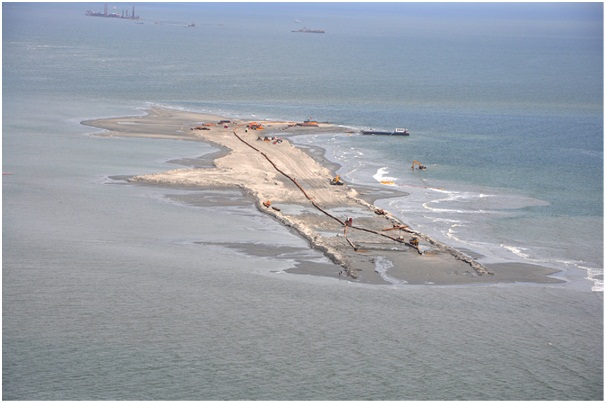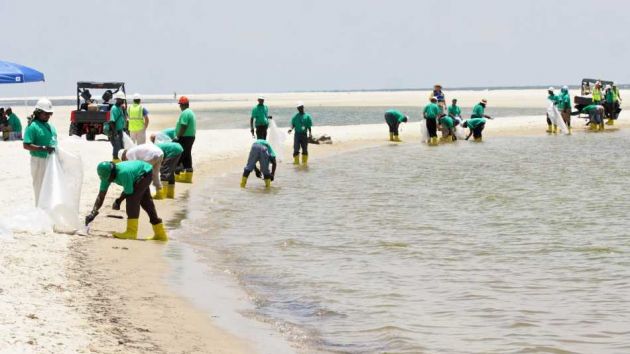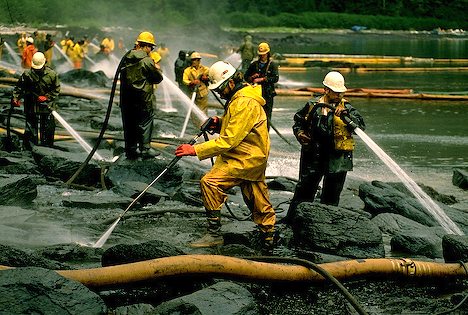Case study of the Gulf of Mexico Oil Spill
Companies that engage in oil and gas exploration, drilling, and production face a wide range of risks, including marine environmental uncertainty, adverse exposures in drilling and construction of offshore oil wells, performance of equipment, and defects in plans and specifications.
On 21 April 2011, an oilrig off the coast of Louisiana at the Deepwater Horizon oil platform run by British Petroleum (BP) in the Gulf of Mexico exploded. The explosion and resulting fire killed more than 10 people and left a number of casualties. The disaster also caused a massive oil leak that has continued to threaten the ecosystem and marine life throughout the Gulf of Mexico. Although the well was finally capped almost three months later, it led to several to several questions regarding the fate and impact of similar spills and the actions we can take to deal with the spill and its after effects.

Mitsch (2010, p 1607) states that ecological engineering is the most important element that should be used to address the effects of oil spills. The author argues that eco-issues must be addressed ecologically. An ecological thinking would clear uncertainties regarding the oils spill such as those witnessed in the aftermath of the Gulf of Mexico spill. These uncertainties lie in the volume of oil that remains the Gulf, the extent of marshes and beaches that have been contaminated by oil, and the lack of good models to forecast the fate and effects of the oil. The author proposes the following strategies for dealing with similar ecological disasters.
Design for Disasters– Plans should be put in place to shut off the source of the problem as soon as it is identified. Although everybody agreed that oil-spill shut off was the best way of countering the Gulf oil spill, engineers spent almost three months trying to shut off the spill. When they finally succeeded in their attempts, nearly 5,000 litres had been released into the Gulf waters.
Do no Harm– this should be a priority while a disaster occurs and the oil spill is contained. No effort at the clean-up process should lead to further ecological damages.
Self-designing ecosystems can help– one of the fundamentals of ecological engineering is to design systems that eventually design themselves (self-design). These systems include use of microbes that anaerobically break down oil into harmless products, or spreading water flow over a large area (in case of rivers) to prevent oil spills from penetrating deeply into the estuaries and marshes.

Economic, social and ecological impacts of oil spills
The recent Gulf oil spill, along with other oil spills, has had a great ecological, economic and social impacts and this has demonstrated the importance of developing responsive and effective oil spill response planning models for the various stakeholders. Zhong and You (2011) have developed an optimization approach for oil spill response planning under the economic and responsive criteria, with consideration of the physicochemical evolution of oil slicks. The approach, known as mixed-integer linear programming (MILP), targets both spill cleanup and protection of coastal areas. The authors state that the multi period MILP model was developed and integrated with the predictions from an oil transport and weathering model that considers the time- dependent oil properties, spilled amount, hydrodynamics, weather, and sea conditions.
The oil spill response- planning model simultaneously predicts the optimal time trajectories of the oil slick’s volume and area, transportation and usage levels of response resources, oil spill cleanup schedule, and coastal protection plan. The multi-objective optimization model was solved with the constraint method and produces a Pareto-optimal curve. Two examples based on realistic oil spill incidents were solved to illustrate the application of this model. The results show that small changes in response time span can lead to significant changes in the total cost and the corresponding response operations. These results in turn suggest the importance of simultaneously considering responsiveness and economics in oil spill response planning.
Engineering ecological systems to clean up oil spills
Oil spills have significant impacts in the sea life such as physical and chemical effects. Etkin et al (2010) points out that although the public was not convinced that engineers were not doing enough, there are simply no foolproof methods of countering an oil spill. He mentions that once the oil spills the water, stakeholders must act in all ways possible to minimize ecological damages. These strategies include those that chemically disperse the oil, suck it away, sponge it up, set fire on it, or divert it from critical areas and their advantages and shortcomings. Before a decision is made on the response towards the disaster, tradeoffs and ecological impacts must be assessed. However, the best strategy is to cut off the oil spill first and the second best is to employ every means in the cleanup process.
Etkin et al (2010) presents the following ecological efforts that can be used in the cleanup process:
- Introducing dispersants on the water surface to disperse oil and hence increase surface area for microbes to break it down;
- Introducing dispersants at the mouth of the leak;
- Burning of spilled oil by collecting it into a thick layer and dropping fames on it;
- Use of skimming machines to vacuum the oil into tanks;
- Use of sorbent materials like mats and sponges to absorb the oil;
- Use of booms to deflect oil from sensitive areas;
- Marsh flushing, where seawater is pumped through the marshes to dilute the oil sticking to grass and other vegetation;
- Cutting down marsh grass in places with heavy oil deposits;
- Mechanized removal of oil sediments, grasses and other wastes;
- Self recovery through tidal waves;
- Manual cleanup of the shorelines;

- Construction of sand berms in July 2010 along Louisiana coastline on Gulf of Mexico for oil spill protection se of high-pressure hoses to remove oil deposits off various surfaces followed by burning;

Dissemination of Information on Disasters
Disasters give no warning of their impending occurrence, but when they do, there are usually limited resources to counter the disaster. For this reason, disaster preparedness is one of the core practices of reducing the effects of disasters when they occur and this can be achieved by disseminating information on various risk mitigation strategies to organizations and the populace. However, before information is disseminated, professionals and other stakeholders must come together in a common forum and discuss the best practices that can be employed in countering specific disasters.
It is for this reason that the Hazards Forum was established in 1989 to provide an interdisciplinary focus for the study of disasters. Lawson (2005) writes that the Hazards Forum is beneficial in engineering disasters. Since its creation, the forum has expanded its roles to enhance public comprehension of risks while continuing to develop its work on the evaluation of disasters, distribution of information and knowledge of risk alleviation methods. Extensive stakeholder views and opinions, including those of the public should, where appropriate, be considered. The Hazards Forum recognizes that it has a major part to play in promoting open, well-timed and active discussions and in making sure that robust, pertinent, independent and accessible information is widely available. In order to perform it score function, the forum has introduced evening meetings during which particular disaster topics are discussed, After every evening event, a report abut the issues discussed is made and this ensures it reaches a wider audience.
In general, the Hazards Forum promotes public understanding of risks, promotes the understanding of particular technological and natural disasters, identifies major lessons from disasters, and functions to alleviate risks and organize national strategies in disaster management similar to the Gulf oil spill.
Conclusion
The engineering responses towards mitigating risks arising from the Gulf of Mexico oil spills were dynamic and revolutionary. Some of the strategies used, such as that of introducing dispersants at the source of the leak, were first used to manage the disaster. Although these methods focus on the Gulf oil spill, they can be used in other oil spills and extended to other environmental disasters. However, as noted earlier, none of these methods is foolproof. Each one has its won benefits and weaknesses and before an engineering team opts for a specific method, or a combination of methods, the economic, social and ecological impact must ne assessed exhaustively so that little harm is done during the cleanup procedure. Besides, coordination among environmental experts, engineers, the government and the public is important so that the views and perspectives of all stakeholders can be considered.
References
Etkin, D. S., Han, J., and Webb, M. (2010). Twelve (Imperfect) Ways to Clean the Gulf. New York Times.
Lawson, D.S. (2005). Engineering Disasters-Lessons to be Learned. New York: ASME Press.
Mitsch, W. J. (2010). The 2010 oil spill in the Gulf of Mexico: What would Mother Nature do? Ecological Engineering, 36 (2010): 1607–1610.
Zhong, Z. and You, F. (2011). Oil spill response planning with consideration of physicochemical evolution of the oil slick: A multi-objective optimization approach. Computers and Chemical Engineering, Volume 35, Issue 8, Pages 1614-1630.
